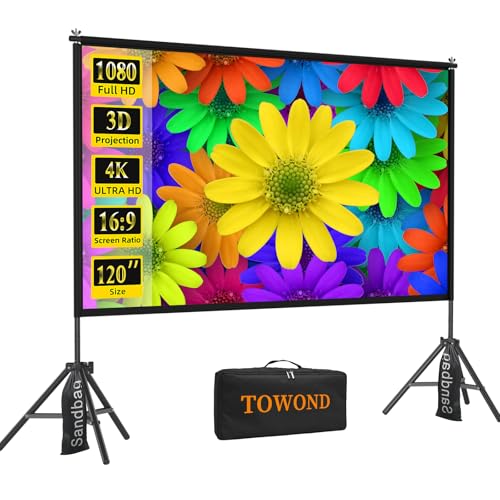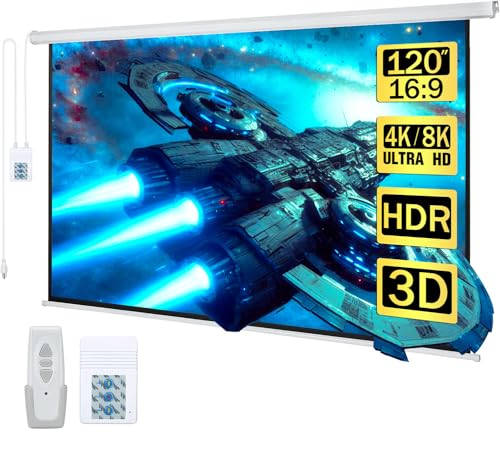There’s a specific kind of low-grade panic that sets in when you’re a professional on the move. For me, it happened five minutes before a crucial client presentation. The conference room I was promised had been double-booked, and I was relegated to a small, window-lit breakout space with beige, textured walls. My meticulously prepared slides were destined for a blurry, washed-out demise. In that moment, I realized that relying on the venue is a gamble; true preparedness means bringing your own canvas. This is the problem the Pyle 50 Inch Portable Projector Screen Tripod aims to solve. It’s not just about watching movies in the backyard; it’s about owning your presentation environment, ensuring your message is delivered with the clarity and professionalism it deserves, no matter where you are. The difference between a crisp, focused image and a distorted projection can be the difference between a signed contract and a missed opportunity.
- PORTABLE & MOBILE PROJECTION: The projection screen stand is lightweight and designed for quick...
- HASSLE FREE SETUP: The digital projection screen is designed for simple setup and universal...
What to Consider Before Buying a Portable Projector Screen
A portable projection screen is more than just a roll of white fabric; it’s a key solution for visual communication and entertainment on the fly. It transforms any space—a classroom, an office, a campsite, or a living room—into a potential theater or presentation hall. Its primary benefit is providing a perfectly flat, color-neutral, and uniformly reflective surface that dramatically enhances image quality compared to projecting onto a wall. A dedicated screen eliminates imperfections, textures, and off-white paint colors that can distort colors and reduce brightness, ensuring your audience sees the image exactly as the creator intended. For anyone who values visual fidelity and needs the flexibility to set up anywhere, a portable screen is an essential piece of equipment. You can explore the specifications of this Pyle model to see how it addresses these core needs.
The ideal customer for this type of product is someone who prioritizes speed, convenience, and mobility. Think of the road-warrior salesperson, the mobile educator giving workshops in various locations, the startup founder pitching in co-working spaces, or the family that wants impromptu movie nights on the deck. They need something lightweight that sets up in minutes and packs away just as fast. Conversely, this might not be suitable for the dedicated home theater aficionado who wants a permanent, large-scale, and perfectly tensioned screen. Those users are better served by fixed-frame or motorized wall-mounted screens that offer larger sizes and cinematic aspect ratios like 16:9, but completely sacrifice portability.
Before investing, consider these crucial points in detail:
- Dimensions & Space: Consider both the screen size and the overall footprint. The Pyle 50 Inch Portable Projector Screen Tripod offers a 50-inch diagonal viewing area, which is ideal for smaller groups or rooms. Also, pay attention to the aspect ratio; this screen’s 4:3 ratio is classic for business presentations and older media but will show black bars (letterboxing) with modern widescreen movies.
- Image Quality & Performance: The screen surface is paramount. A matte white finish, like the one on this Pyle screen, is the industry standard for its excellent color accuracy and wide viewing angle, meaning people sitting off to the side will still see a clear picture. The gain (a measure of reflectivity) is also important; a standard 1.0-1.1 gain provides a bright image without creating “hot spots.”
- Materials & Durability: A portable screen will be handled, transported, and set up frequently, so durability is key. Look for a sturdy metal casing (like the aluminum one here) to protect the screen when retracted. The tripod base should be stable and made of robust materials to prevent wobbling, especially if used outdoors where a breeze could be a factor.
- Ease of Use & Maintenance: How quickly can you go from packed to projecting? A pull-up tripod design like this one is among the fastest and most intuitive systems available. For maintenance, a smooth, non-porous surface is easier to clean with a soft, damp cloth to remove any dust or smudges that might accumulate over time.
While the Pyle 50 Inch Portable Projector Screen Tripod is an excellent choice for portability, it’s always wise to see how it stacks up against the competition. For a broader look at all the top models, from portable to permanently installed, we highly recommend checking out our complete, in-depth guide:
- CONVENIENT TO STORAGE AND CARRY : Compact one-piece,lightweight and folding design. You can fold the...
- NEW GENERATION CHASSIS AND ACCESSORIES:We tackle the issue of unstable projector screen with stand...
- Projector Screen with Stand: 120-inch diagonal, 16:9 aspect ratio, 160° viewing angle, HD...
Unboxing the Pyle 50 Inch: First Impressions and Key Features
Pulling the Pyle 50 Inch Portable Projector Screen Tripod from its shipping box, the first thing we noticed was its integrated, all-in-one design. The entire unit—tripod, stand, and screen housing—is a single, self-contained piece. At just under 10 pounds, it felt substantial enough to be stable but light enough to be genuinely portable. The black aluminum casing that houses the retracted screen feels tough and ready for the rigors of travel. As many users have pointed out, there’s a notable omission: a carrying bag. This was an immediate and obvious drawback for a product built around mobility. For now, the original box and a bungee cord would have to suffice.
Despite this, the initial impression of the mechanism itself was positive. The tripod legs folded out smoothly, and the central mast extended with a simple twist-lock mechanism. The entire apparatus felt intuitive. There were no loose parts to assemble or instructions to decipher; it was clear this screen was designed for people who don’t have time to waste. For anyone who has fumbled with complex stand-and-fabric screens, this self-contained design is a breath of fresh air and a major selling point that you can see demonstrated in online videos.
Advantages
- Extremely fast and intuitive setup and teardown
- Lightweight, self-contained design for easy transport
- Smooth, wrinkle-free matte white screen surface
- Highly adjustable viewing height for versatile placement
Drawbacks
- Does not include a carrying bag or case
- Reports of inconsistent quality control (dents, rust)
In-Depth Performance Analysis: Putting the Pyle Screen to the Test
A product can look good out of the box, but the real test is how it performs in the field. We put the Pyle 50 Inch Portable Projector Screen Tripod through its paces in various scenarios, from office presentations to a twilight movie night on the patio, to see if its performance lived up to its promise of convenience.
The Setup and Teardown Experience: Simplicity Redefined
This is where the Pyle screen truly shines and, frankly, blows most of its competition out of the water. The setup process is so quick and effortless it feels almost automatic. We timed it: from its fully collapsed state to a ready-to-use screen took us, on the first try, just under 45 seconds. One user perfectly captured this by saying it “almost sets itself up,” and we wholeheartedly agree. The process is dead simple. First, you flip out the three tripod legs until they lock into a stable base. Second, you rotate the entire screen housing from its vertical transport position to the horizontal viewing position. Third, you extend the telescoping mast to your desired height and secure it with a quick turn of the friction lock. Finally, you grab the handle and pull the screen up, hooking it onto the built-in hanger at the top of the mast.
The tensioning mechanism within the housing does a fantastic job of keeping the screen taut and perfectly flat, eliminating the wrinkles and creases that plague foldable fabric screens. The height adjustment is also a key feature, allowing the bottom of the screen to be set anywhere from 25 to 48 inches off the ground. This versatility means you can set it on the floor for a presentation or on a tabletop for a more intimate viewing. Tearing it down is just as rapid—unhook the screen, let it retract smoothly into its protective casing, lower the mast, fold the legs, and you’re done. This speed is not a gimmick; it’s a game-changing feature for anyone who needs to set up and break down their equipment multiple times a day. For mobile professionals, this efficiency is invaluable, and it’s a feature that really sets it apart.
Visual Performance: Matte White Magic for Any Setting
A fast setup means nothing if the image quality is poor. Fortunately, the Pyle 50 Inch Portable Projector Screen Tripod delivers a very competent visual performance. The premium white matte fabric provides a neutral, uniform surface that renders colors accurately without any noticeable color shift. We projected a mix of content—text-heavy spreadsheets, colorful presentation graphics, and high-definition video clips—and were consistently pleased with the results. The image was crisp, clear, and vibrant. The black masking borders on all four sides are a professional touch often omitted on budget screens. These borders don’t just frame the image; they actively enhance perceived contrast, making the picture appear punchier and more focused.
We tested the screen in a moderately lit room, and as several users confirmed, it performs admirably. While a completely dark room will always yield the best results, the screen’s surface does a good job of rejecting some ambient light, making it perfectly usable for meetings where you can’t achieve total darkness. The 4:3 aspect ratio is an important consideration. For PowerPoint presentations or older, non-widescreen content, it’s a perfect fit. When we projected a 16:9 movie, we simply adjusted the projector’s zoom to fit the screen’s 40-inch width, resulting in black bars at the top and bottom. As one user noted, it’s “not true 16:9 but effective still.” For its intended purpose of versatile, multi-format viewing, this is a smart compromise. The wrinkle-free surface is the final piece of the quality puzzle, ensuring there are no distracting lines or waves to break the immersion. For its price point, the visual fidelity is impressive.
Portability and Durability: A Road Warrior’s Mixed Bag
Here, our experience was more nuanced. On the one hand, the product’s design is inherently portable. Its all-in-one, self-contained form factor is brilliant. There are no separate bags of poles or fabric to keep track of. You grab one item, and you have everything you need. At under 10 pounds, carrying it from the car to a meeting room is no trouble at all. Once set up, the tripod base proved to be quite stable on flat indoor surfaces. We even used it on a slightly uneven patio, and with a little adjustment, it held its ground without any unnerving wobbling.
However, the portability story is marred by two significant issues. The first, and most universally cited by users, is the baffling lack of a carrying bag. The aluminum housing can get scuffed and the plastic end caps can get chipped during transport. More annoyingly, without a strap or bag, carrying it for any distance longer than a short walk can be awkward. We, like many others, resorted to keeping it in its original cardboard box, which is a flimsy and temporary solution. This is a major oversight for a product sold on its mobility.
The second issue is quality control, which appears to be inconsistent. While our test unit arrived in perfect condition, we cannot ignore the significant number of user reports detailing issues right out of the box, including dents in the metal casing, a weak central mast, and even rust spots on the stand. This suggests a lottery-like experience. Our advice is to inspect the unit thoroughly upon arrival and be prepared to process a return if you receive a defective one. If you get a good unit, the durability seems adequate for careful use, but it doesn’t feel over-engineered to withstand heavy abuse. This is a critical factor to consider before you commit to making a purchase.
What Other Users Are Saying
After our own extensive testing, we dug into a broad range of customer feedback to see how our experience aligned with the wider consensus. The sentiment is largely positive, with a few recurring caveats. Overwhelmingly, users rave about the setup. Phrases like “extremely easy to setup,” “almost sets itself up,” and “a breeze” dominate the reviews, confirming our own findings that this is the product’s killer feature. Many also praise it as a fantastic value, calling it “great BANG FOR THE BUCK” and perfect for business meetings, church groups, or casual movie nights.
On the negative side, the most common complaint by a wide margin is the absence of a carrying bag. Users are clearly frustrated by this, with one noting, “Only thing missing here that would really make it PORTABLE is some sort of bag.” The other significant point of contention is quality control. We found several alarming reviews similar to one user who called it “Absolute trash” after receiving a unit with dents and a weak, non-functional stand. Another reported “many rust spots exposed on the shaft section” on a brand-new unit. This feedback is crucial; while the design is excellent, the manufacturing consistency can be a gamble.
How Does the Pyle Screen Compare to the Competition?
The Pyle 50 Inch Portable Projector Screen Tripod occupies a specific niche, but it’s important to understand the alternatives. Depending on your needs for size, format, and convenience, other products might be a better fit.
1. Kayle 120 Motorized Electric Projector Screen 16:9
- 【Widescreen Aspect Ratio】The projector screen features a 16:9 viewing format, same aspect ratio...
- 【Screen Material】Featuring a 180° viewing angle and 1.2 gain, 3 layer premium black backed...
The Kayle 120 is on the opposite end of the spectrum from the Pyle. This is a large, 120-inch, motorized screen designed for permanent installation in a home theater or conference room. Its primary advantage is sheer size and convenience; with the push of a button on a remote, a massive 16:9 widescreen surface descends from the ceiling. A user would choose the Kayle over the Pyle if their goal is to create a dedicated, immersive cinema experience in a single room and portability is not a factor whatsoever. The Pyle is for going places; the Kayle is for staying put in style.
2. HOIN 80 inch Portable Projector Screen
- 【Projector Screen Indoor】- Folding Mini projector screen , 160° Wide Viewing Angle, the...
- 【Express Setup】 - The projector screen and stand is ready for quickly set-up in few minutes....
The HOIN 80-inch screen is a more direct competitor in the portable space. It offers a larger, 16:9 widescreen viewing area, making it better suited for modern movies. Unlike the Pyle’s integrated design, the HOIN consists of a separate foldable frame and a stretchable fabric screen that attaches to it. While this design allows for a larger screen that packs down into a smaller bag (which is included), the setup process is invariably more complex and time-consuming. A user might prefer the HOIN if a larger, widescreen format is a top priority and they don’t mind a slightly longer assembly time. The Pyle wins on speed and simplicity; the HOIN wins on size and native widescreen format.
3. Kshioe Motorized Projector Screen 92inch
- Perfect visual enjoyment: 16: 9 Projectorscreen format and diagonal 92" offers 80" x 45" viewing...
- Wireless remote: The remote is a nice touchwhen you need to operate Motorized Projector Screen...
Similar to the Kayle, the Kshioe 92-inch screen is a motorized, wall-mounted option intended for a fixed location. It offers a generous 92-inch diagonal in a 16:9 aspect ratio, making it an excellent mid-size choice for a dedicated media room or office. It provides the same push-button convenience as other motorized screens, eliminating any manual setup. The choice between the Kshioe and the Pyle comes down entirely to application. If you need a high-quality screen for one room that you can hide away when not in use, the Kshioe is a great option. If you need to present in multiple rooms, cities, or even outdoors, the Pyle’s grab-and-go functionality is the only logical choice.
Final Verdict: Is the Pyle 50 Inch Portable Projector Screen Tripod Right for You?
After extensive hands-on use and analysis, our verdict on the Pyle 50 Inch Portable Projector Screen Tripod is clear: for the right user, it is an absolutely brilliant and invaluable tool. Its masterstroke is the unparalleled speed and simplicity of its setup and teardown. In less than a minute, you can have a flat, stable, and high-quality projection surface ready to go in any location. This single feature makes it a top-tier choice for mobile professionals, educators, and anyone who values efficiency above all else.
However, it’s not a perfect product. The lack of a carrying bag is a significant, almost inexplicable oversight that detracts from its overall portability. Furthermore, the reports of inconsistent manufacturing quality mean buyers should be vigilant. Despite these flaws, the core functionality is so strong and the value proposition so compelling that we can confidently recommend it. If your primary need is a small-to-medium screen that you can deploy at a moment’s notice for presentations or casual viewing, you will be delighted. If you can live with sourcing your own carrying solution and are prepared to inspect it upon arrival, the convenience it offers is second to none. For those who fit this profile, the Pyle 50 Inch Portable Projector Screen Tripod is an excellent investment in professional readiness and portable entertainment.







